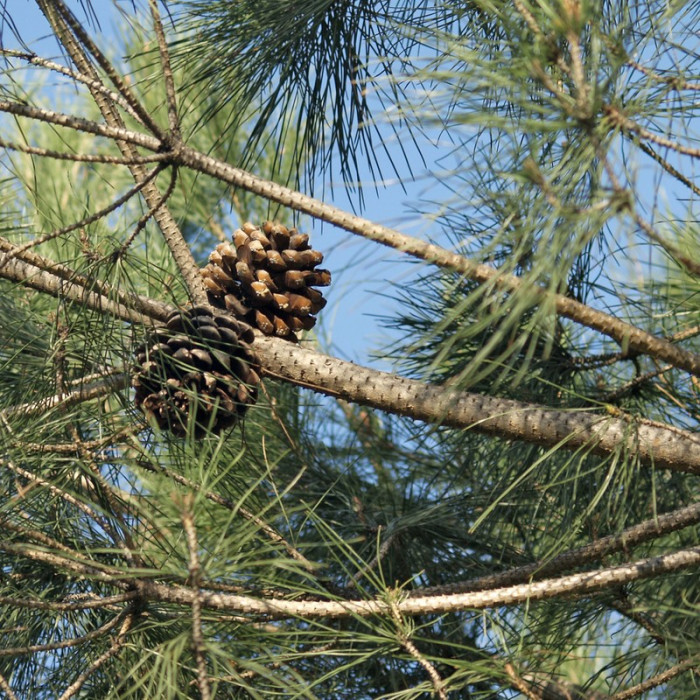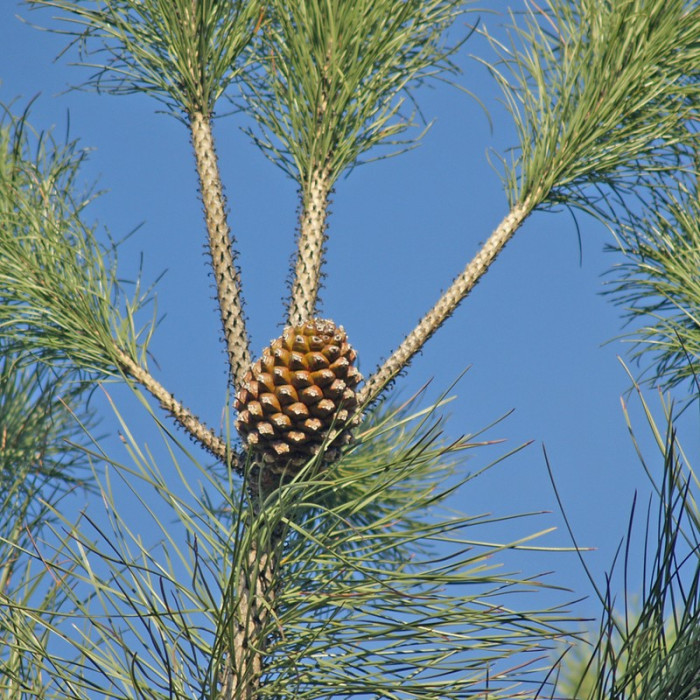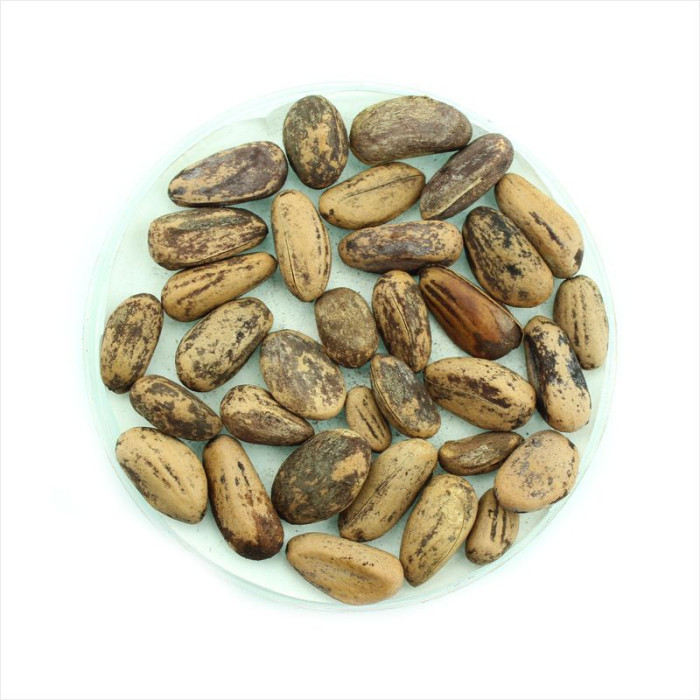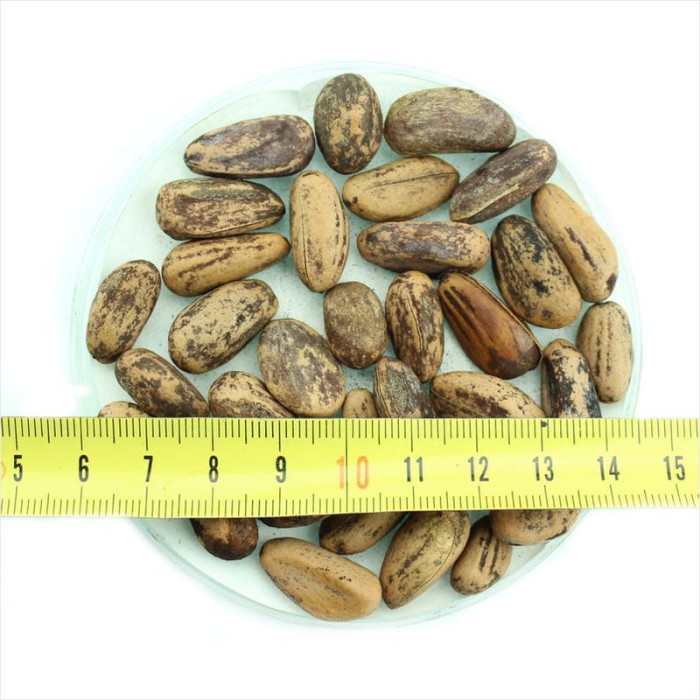Italian stone pine, also known as the Mediterranean stone pine / Pinus pinea - a tree from the pine family, naturally found along the Mediterranean coast from the Iberian Peninsula to Asia Minor. It grows to a height of 20–30 meters and can live up to 500 years. Its crown is dense, dark green, umbrella-shaped, and compact, with older trees having horizontally spread branches. The needles are in pairs, long (10–15 cm), narrow, dense, green year-round, sometimes with a bluish tint.
Ornamental and Historical Use
This beautiful tree was used as an ornamental plant by the Etruscans and remains popular today. It’s well-suited for bonsai art. Cones are usually solitary or in groups of 2–3, measuring 8–15 cm, egg-shaped or nearly spherical. Seeds mature in the third year (October), but cones don’t open until the following spring. After seed release, cones remain on branches for another 2–3 years.
Seeds and Yield
Seeds are elongated-oval, dark brown with light spots, three-ribbed, 15–17 mm long and 8–9 mm wide, with a thick shell and a short narrow wing. They are edible and the largest among all pine species—3–4 times bigger than the "cedar nuts" known in Eastern Europe. One kilogram contains about 1,500 seeds. Yields are high: 3–8 tons per hectare. In Italy, they’re called "pignoli."
Growing Conditions
Stone pine is sun-loving and drought-resistant, not demanding of soil, growing on dry limestone and coastal sands, though it prefers fresh, loose soils. It does not tolerate excessive moisture. It withstands frosts down to -18°C and is wind-resistant.
Cultivation and Use
Seeds germinate without pre-treatment. It’s a valuable ornamental and nut-bearing tree. Seeds are widely used in confectionery. Cultivated in southern Crimea and the Caucasus. Fun fact: Pinocchio (known in Russia as Buratino) was made from a pine log. Avicenna used pine bark decoctions medicinally.
Cedar Seed Germination and Propagation
Conifer seeds remain viable for up to 4 years. After sowing, seeds are lightly covered with soil. They germinate in the year of sowing or the next, rarely in the third year. After sprouting, young seedlings should be shaded and watered. In the second year, they develop only the apical shoot; in the third year, the first whorl of lateral shoots forms. The crown develops by 5–7 years, and by 15–25 years, branches reach near the ground. At 20–30 years, lower branches die off, and the crown becomes egg-shaped.
Vegetative Propagation
Used in specialized nurseries (seed plantations, cedar orchards) via grafting (cedar to cedar), cuttings, or combined methods (grafting at the root collar followed by rooting). Cedars, like most conifers, reproduce by seed, though some (like creeping cedar) can form adventitious roots, allowing vegetative propagation.
Seed Harvesting and Stratification
Cedar seeds are harvested from mid-August to mid-November. If cone maturation is delayed, collection occurs in spring. Two main methods are used: climbing into crowns and “knocking.” In village groves, climbing is easy; in tall forests of the Sayan-Altai region, professional “tree climbers” harvest cones from trees 30–38 m tall with raised crowns.
Siberian and European cedar seeds undergo stratification at -4 to +3°C for 3–5 months. Korean cedar seeds require two stages: 3 months at 18–20°C, then 2–3 months at -2 to +4°C.
Stratification is done in ice cellars, deep trenches, cold basements, boxes under snow, or refrigeration. Seeds are mixed with 2–3 times the volume of sterile substrate (sand, sawdust, peat, moss). Seed moisture should be 20–40%; substrate should be at field capacity. Good drainage and rodent protection are essential.
Storage and Sowing
To maintain viability, seeds can be stored up to 2.5 years in deep trenches (2.5 m), which maintain low temperature and humidity. For faster germination and reduced rodent loss, slightly sprouted seeds are used in spring. Sowing density: 120–140 seeds per linear meter at 3–4 cm depth. Protect sprouts from birds with sawdust cover (3–4 cm) and fine mesh netting. The most promising method is growing seedlings in cold greenhouses with polyethylene covers, which shortens the time to standard seedlings by 1.5–2 times. Cedar seedling cultivation is similar to other conifers: shading, watering, protection from lodging, loosening, and weeding.

No questions about this product, be the first and ask your question.














